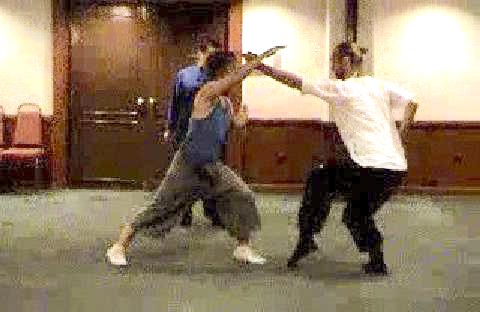FROM PRE-ARRANGED SPARRING TO GUIDED SPARRING
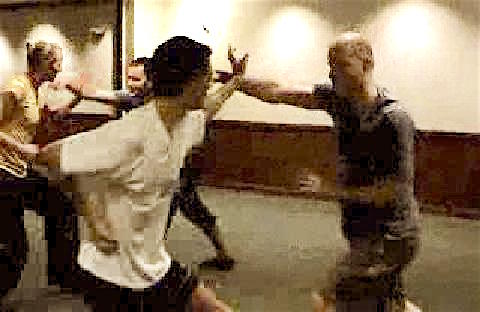 Participants at the Intensive Shaolin Kungfu Course of October 2006 enjoying guided sparring
Participants at the Intensive Shaolin Kungfu Course of October 2006 enjoying guided sparring
Very few kungfu practitioners of any style today can use kungfu patterns for sparring. The situation has become so bad that some masters even think that kungfu cannot be used for fighting!
Of course, kungfu can be used for fighting. Records clearly show that kungfu practitioners in the past effectively used kungfu patterns and skills for combat. Some members in our Shaolin Wahnam Family also used kungfu effectively in real fights. We do not glorify fighting, and would rather not fight if given a choice, but we can speak from experience that kungfu is effective for fighting.
We are very fortunate that we still have an effective sparring methodology that enables us to use kungfu for combat, and as part of our effort to restore the greatness of kungfu irrespective of its styles, we are willing to share some of the secrets with others if they are interested and deserving. Many of these secrets are revealed in this and other webpages.
This video series shows the early stages of our combat application training. After we have learnt some basic techniques and developed some combat skills, we apply them in pre-arranged sparring. Gradually our pre-arranged sparring evolves into guided sparring where course participants spar spontaneously using kungfu skills and techniques. The progression from guided sparring to free sparring will be shown in later video series.
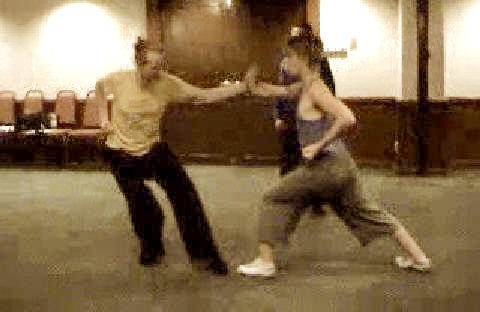 An Encounter of Attacks and Defences
An Encounter of Attacks and Defences
The initiator and the responder enconter a series of attacks and defences form a sequence. We call this sequences “Black Tiger Steals Heart” after its most popular pattern.
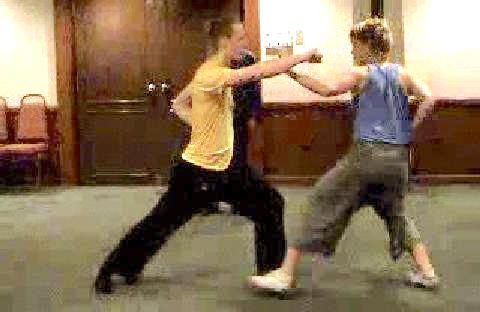 Sequence 1: Black Tiger Steals Heart
Sequence 1: Black Tiger Steals Heart
The sequence “Black Tiger Steals Heaart” is practiced smoothly as if it is one long, continuous pattern. Although this sequence is very simple, it is much liked and most practiced by Shaolin students of our school because it offers great opportunities to deepen some essential combat skills.
An extra pattern, “Poisonous Snake Shoots Venom”, is added to the sequence. To maintain uniformity for the purpose of training, the first Black Tiger is removed so that the sequence now consists of three attacks composing of Black Tiger, Black Tiger and Poisonous Snake.
 Sequence 2: Poisonous Snake Shoots Venom
Sequence 2: Poisonous Snake Shoots Venom
The second combat sequence, “Poisonous Snake Shoots Venom”, is performed in a continuous flow. Notice the effective use of footwork for attack and defence. Later when you are more skillful, you can run a defence pattern and an attack together as if they were one continuous pattern instead of two separate patterns. This forms a smooth movement implementing the “swallow-shoot” tactic.
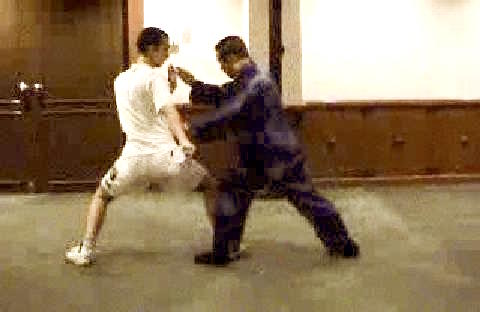 Weaknesses if Moving too Close
Weaknesses if Moving too Close
After completing Combat Sequence 2, a low strike using “Precious Duck Swims Through Lotus”. is added However, in executing the added pattern, the student moves in too close which is a weakness, allowing a skillful opponent to strike him or fell him onto the ground.
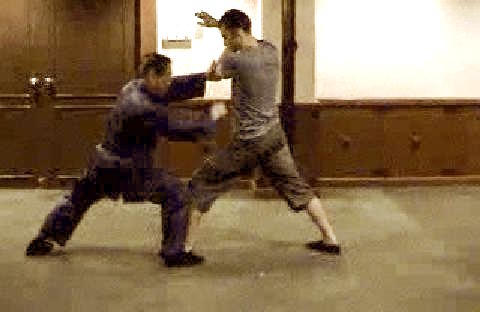 The Essential Tenet of Safety First
The Essential Tenet of Safety First
We must move in to attack without compromising our own safety. “Safety first” is an essential tenet in kungfu, and in life. There are two considerations to ensure safety, namely footwork adjustment and coverage.
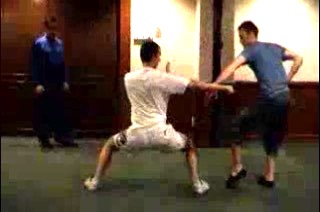 Sequence 3: Precious Duck Swims Through Lotus
Sequence 3: Precious Duck Swims Through Lotus
Sequence 3 is developed from the previous sequence by adding one pattern at the end and taking away one pattern at the beginning. A student does not conclude the responder's mode with the last pattern which is a Black Tiger. A skillful exponent may take this opportunity to hit an ordinary opponent. This sequence provides good training for us to avoid such a hit by enabling us to develop spontaneous footwork to retreat if necessary.
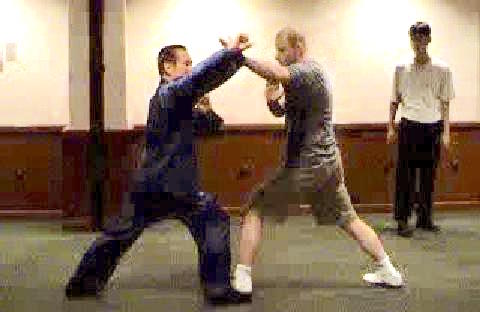 Sequence 4: Hang a Golden Star at a Corner
Sequence 4: Hang a Golden Star at a Corner
Sequence 4 is a development from Sequence 3. The initiator circulates his hand around the sweeping arm to “tame” it, and follows up with a horn-punch. The responder intercepts and counters with a Black Tiger. It is essential to cover an opponent arm before moving close with a horn-punch, otherwise the responder would jab into the initiator's ribs.
 Response According to Opponent's Move
Response According to Opponent's Move
Sequence 4 and Sequence 3 are similar. Hence, at the self choice stage, you may have planned to attack using Sequence 4, but if your sparring partner counter-attacks before you can follow with a horn-punch, you would have to defend againt the attack, which therefore changes your sequence to Sequence 3. This provides an opportunity for approaching free sparring.
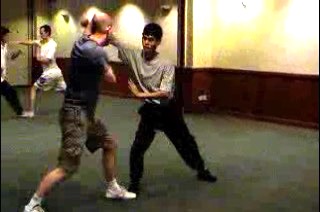 All Typical Strikes within the Sequence
All Typical Strikes within the Sequence
This is Combat Sequence 4, which is called “Hang a Golden Star at a Corner”. All the four basic strikes are found in this sequence. Even within a few minutes between the previous video clip and this one, there is discernable improvement in the performance of the sequence, especially in fluidity of movements and force applied.
 Continuing with Another Sequence
Continuing with Another Sequence
When you can perform one sequence well, add another sequence. For example, you may start with Sequence 1 and continue with Sequence 4, or start with Sequence 3 and continue with Sequence 3 too. Note the change of leg-mode in between sequences.
A major probelm faced by many kungfu practitioners when using kungfu patterns in sparring or real fighting is being hesitant due to not knowing what techniques to use next. You can overcome this problem by using the method of continuation as shown in this video clip.
Participants use kungfu patterns to spar spontaneously. The movements are not predetermined, but it is also not totally free. For convenience we call it guided sparring, i.e. the combatants follow certain guidance which enables them to spar spontaneously using kungfu patterns.
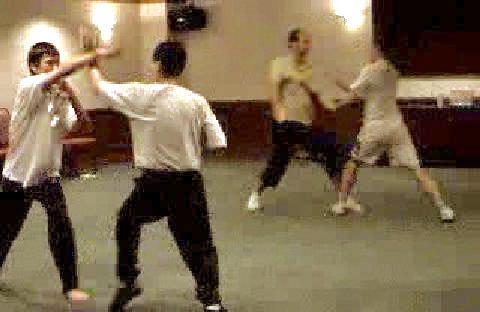 Sequence Continuation for Coherent Sparring
Sequence Continuation for Coherent Sparring
There are some guidelines or methods you can use to enable you to spar spontaneously without thinking of what patterns to use next, yet your attack and defence is coherent and fluid. The main method used here is continuation, making use of Combat Sequences 1 to 4. Can you tell what sequences the combatants use to continue from what other sequences?
 Sparring can be Fun and Injury Free
Sparring can be Fun and Injury Free
The participants are not only not injured in their sparring but also have a lot of fun. They are able to maintain a coherent and fluid flow of sparring using kungfu patterns by following the method of sequence continuation. Anyone can initiate with any one of the Sequences 1 to 4, and he or his partner continues with any sequence.
From Pre-Arranged Sparring to Guided Sparring from Wong Kiew Kit on Vimeo.
1. Stances: the Foundation for Internal Force and Combat Efficiency
2. Footwork Secrets for Health, Efficiency and Elegance
3. Moving into a Same Direction using Different Ways to Gain Advantages
4. Picture-Perfect Forms and Flowing Movements
5. From Random Fighting to Patterns, and from Patterns to Sequences and Sets
6. One-Step Sparring to Develop Combat Skills
7. From Pre-Arranged Sparring to Guided Sparring
8. Using Techniques and Tactics in Sparring
9. The Five Basic Kicks
10. The Secrets of Side Kicks and Continuous Cannons
11. How You may Defeat Opponents Experienced in Random Free Sparring
12. How Would a Fragile Girl Counter a Powerful Sweeping Kick from a Muay Thai Fighter?
13. Shaolin Felling Techniques and their Defences
14. Safety First Before Executing Felling Techniques
15. From Combat Sequences to Free Sparring
16. Sixteen Combat Sequences and Five Kungfu Sets
17. Surprise your Attacker with a Counter-Attack
18. Working out Ways to Fight a Boxer
19. Effective Tactics and Techniques against Boxers
20. From Gross Outline to Fine Details
21. Exploiting Advantage to Clinch Victory
22. Variety of Kungfu Techniques against Boxers
23. Analysis of Techniques Used against Boxers
24. Using Shaolin Kunfu against Boxing in Free Sparring
25. Effective Shaolin Tactics and Techniques against Kick-Boxing
26. Shaolin Kungfu against Kick-Boxing in Free Sparring
27. How to Handle a Karate Exponent
28. How to Handle a Taekwondo Exponent
29. How to Handle a Wrestling Exponent
30. Understanding the Typical Attacks of Muay Thai Fighters
31. Grandmaster Ho's Secrets in Countering Muay Thai Fighters
32. First Avoid Defeat, Then Secure Victory
33. Counteroing the Elbow and Knee Attacks of Muay Thai Fighters

